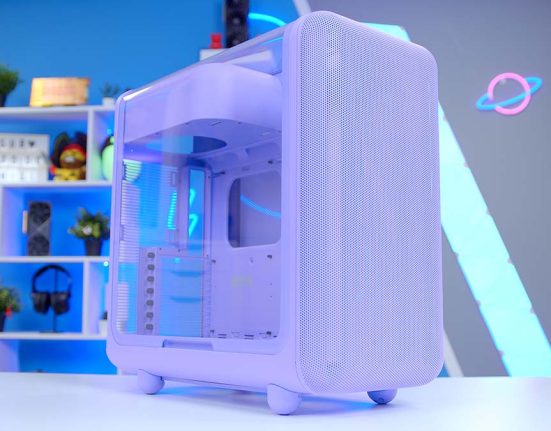Introduction
When HYTE released the Y60 in March 2022, it immediately took the PC building landscape by storm. As a PC case designed for enthusiasts, the wrap-around glass quickly became the best way to show off gaming PCs filled with premium hardware.
Since then, it seems as though HYTE have been thinking of ways to elevate the appeal of this design even further, hoping that lightning will strike twice. After releasing the more budget-oriented HYTE Y40 in January 2023, they are heading back to the enthusiast market with the HYTE Y70 Touch. Boasting many of the characteristics that Y60 users have come to know and love, the Y70 Touch introduces an integrated touchscreen into the mix, in the attempt to add even more wow-factor to this trailblazing design.
Suggested Article: Best RGB PC Cases to Buy in 2023
But are the improvements on the Y60 nothing more than a wacky gimmick? Or does the HYTE Y70 Touch offer enough enhancements to topple its predecessor as the best PC Case for a high-end system? To find out, we’ll be taking a closer look at the HYTE Y70 Touch, testing the design, features, and practicality of this chassis.
Buy the HYTE Y70 Touch on:
Why are Fish Tank PC Cases so Popular?
Over recent years, PC cases such as the HYTE Y60 and Lian Li O11 Dynamic Mini have cause the popularity of the so-called ‘fish tank’ designs to soar in popularity. Especially within the enthusiast market, these cases have become the go-to choice to house the best components on the market. As a result, lots of manufacturers have replicated this design, leading to a range of these cases with slight variations in size and pricing.

But what makes this particular design so popular? The general consensus seems to be that cases which adopt the fish tank design offer the most aesthetically pleasing way to show off all the parts within a PC build. With the ability to orientate a graphics card either vertically or horizontally, as well as giving users the chance to side mount a large CPU Cooler, these displays ensure that none of the design choices on these parts will be hidden behind the frame or panels, allowing your system to look as good as it runs.
HYTE Y70 Touch Design & Aesthetic
Taking a look at the HYTE Y70 Touch specifically, the first section of the case that will catch your eye is the LCD screen embedded into the glass panels. Whilst it does obstruct the vision of the components inside at certain angles, this feature adds an extra dimension to the case, both in terms of visual appeal and functionality. We acknowledge that having a touchscreen on a PC case of all things is very bizarre -perhaps slightly overkill- but it certainly turns heads and starts conversations, which is arguably its main purpose.
Apart from the installation of a touchscreen, this case shares a lot of similarities with the HYTE Y60, to a point where it’s hard to find any differences between the two. Those with a keen eye will notice that the Y70 Touch is slightly bigger than the Y60, but this doesn’t have much of effect on how you would use this chassis. It may sound like a negative point, but the design of the HYTE Y60 is exceptional, so there’s no reason to fix what isn’t broken.

For those unfamiliar with HYTE’s previous designs, the Y70 Touch is comprised of tempered glass along the front and side of the case, creating an L-shaped form factor that heavily favours one side. Because of this, the HYTE Y70 Touch is best utilised when located on the right-hand side of a desk, or with the back panel up against the wall, as this will allow the components to be on full display at all times.
On top of this, the HYTE Y70 Touch is available in a variety of different colours, such as black, white, black/white, and red. This allows users to choose the colour that will fit the best within their setup, with each colour-scheme significantly changing the exterior surrounding the glass panels and screen.


Features We Like
Integrated Touchscreen
An integrated LCD display is by no means a new concept for PC cases. However, we’ve never seen a design that makes the screen such an integral part of the design. Usually, the screen is an optional extra that can show a few key statistics, but this case allows the touchscreen to span the whole corner section of the chassis. This results in a 14.1″ 4K 60Hz display, which can almost be used as a bonus display for your setup. Additionally, HYTE have developed their own ‘Nexus Touch’ software, which offers a plethora of widgets and apps that let users take advantage of gestures and simplified touch-based navigation.
In all honestly, the amount of activities and tasks you can use this screen for is pretty mind-blowing, Whilst a lot of the widgets and extensions do feel like a gimmick that you will quickly lose interest in after a few uses, the functionality on offer shows that HYTE have put a lot of thought and effort into how this standout feature could enhance the user experience.



Included PCI-E Riser
In a similar fashion to the previous HYTE cases we’ve reviewed, the Y70 Touch comes with a PCI-E riser cable. This allows users to mount their GPU vertically, without having to worry about buying an external add-on. On top of this, each of the PCI-E risers are matched to the colour of the PC case, which means it won’t stick out like a sore thumb.

Extensive Fan & Radiator Support
With the HYTE Y70 Touch boasting a fairly large from factor, it won’t come as much of a surprise to hear this chassis includes plenty of cooling support. This case has the ability to hold up to 10 x 120mm fans in total, with a maximum radiator support of 360mm. Therefore, the HYTE Y70 Touch should have no issues with airflow, even in a system packed with power-hungry components. To counter the heavy use of glass panels throughout the design, this case includes plenty of ventilation on the remaining panels. including the bottom, preventing hot air from getting trapped in the glass housing.

Dual-Chamber Design
From a practical point of view, the HYTE Y70 Touch adopts a dual-chamber layout, which makes it easier to assemble your system in a way that keeps the build looking clean and tidy. To support this further, the Y70 Touch comes with a number of cable management features, such as Velcro straps, tool-less panels, and routing channels.

Features We Don’t Like
Limited Options on Case IO
One of the biggest weakness of this case is the IO, as the ports on offer for connecting peripherals and accessories are fairly limited. With two USB-A and one USB-C port, the Y70 Touch provides just enough connectivity to support a keyboard, mouse, and headset combination, as long as they all aligned with the ports on offer. On top of this, I’m not a fan of where the IO is located. Sitting just below the LCD display, having wires running from the corner of the case and underneath the display won’t be the most practical or pleasing to the eye. Because of this, I’d assume that most users will opt to use their rear IO to connect their devices instead, mainly to keep the case looking pristine.

Lack of improvements from the Y60
Compared to HYTE’s previous design, the Y70 Touch doesn’t offer the enhancements needed to convince us that this chassis is the superior choice between the two. Whilst the touchscreen is the main selling point of the HYTE’s latest offering, consumers can pick up a LCD DIY Kit for the Y60, which leads to a total cost that is $9 cheaper than the Y70 Touch at MSRP. Granted, users would have to install the lower resolution screen available in the DIY Kit themselves, but it offers existing HYTE Y60 owners a simple alternative.


When you the put the touchscreen to one side, the only other advantage the Y70 Touch has over its predecessor is a slightly larger form factor. This leads to improved clearance for parts such as GPUs and coolers, but these changes will only impact a select few.
Alternatives
HYTE Y60

The comparisons between the HYTE Y60 and the Y70 Touch have already been discussed in detail during the evaluation of HYTE’s latest design, as there are lots of similarities between the two options. Ultimately, the main reason why you’d consider one design over the other depends on whether the integrated LCD display would be a welcomed addition to your setup. For those not interested in utilising the screen on the HYTE Y70 Touch, then the Y60 is the best choice for you.
Buy the HYTE Y60 on:
NZXT H9 Elite

If you are looking to move away from HYTE’s offerings entirely, then NZXT’s H9 Elite is a strong alternative. Whilst it still maintains the popular fish tank design, this case also possesses a more conventional box shape. With a dual-chamber layout, side-mounted cooling, and plenty of ventilation to counter the glass panels, H9 Elite customers will be getting a similar experience to building in a HYTE case, just with more of NZXT’s minimalist approach.
Buy the NZXT H9 Elite on:
Conclusion
HYTE Y70 Touch

Product Name: Y70 Touch
Brand: HYTE
-
Features
-
Design
-
Versatility
-
Value For Money
Summary
Since the HYTE Y70 Touch arrived at the GeekaWhat office, there has been plenty of debate and deliberation over this chassis. Whilst we all appreciated that an LCD display on a PC case is slightly overkill, which mainly there to add some wow-factor, HYTE have done an excellent job at integrating this gimmick into an already established and beloved design. And though the fundamentals of this design are almost identical to the Y60, this revision adds another layer to the design, which is bound to impress enthusiasts.
If HYTE had simply stuck an LCD display on the case without much thought and left it for the consumer to figure out how to use it, I would have questioned and scrutinised the intentions and value of the Y70 Touch a lot more. But after seeing the display in action, messing around the Nexus Touch software and navigating through the various apps and widgets, the thought of utilising the screen during day-to-day use became less of a pipe dream. Granted, we can’t imagine keeping track of the virtual pet or playing endless rounds of ‘Block Game’ (if that’s what they want to call it), but the ability to control your media settings on the fly or monitor your twitch chat without having to take up precious monitor real-estate seems like a handy quality-of-life improvement.
But let’s get one thing straight, this PC case is certainly not for everyone. If you don’t want to splash out a ludicrous amount on a PC case, or planning to keep your PC under the desk, there’s not much point in even considering this case. This case is simply meant to be shown off, so having it filled with the best components on the market is a must in order to create a build that is truly jaw-dropping. A lot of people will look at the price tag and lack of improvements from the cheaper Y60 and immediately declare this case as the wrong option for them, and rightfully so. On the other hand, those enthusiasts that want a PC that turns heads and blows the minds of their family and friends, then the Y70 Touch is certainly a top contender.
Pros
✅ Eye-catching & innovative design.
✅ Integrated display is excellent.
✅ Great for PC building enthusiasts.
Cons
❌ Very expensive.
❌ Lots of similarities with the Y60.
❌ Restricted capacity for larger components.








